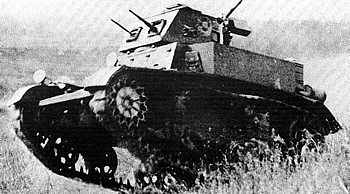
Last updated on February 17th, 2019 at 09:50 pm
By the time World War II began in Europe, the United States had four kinds of light Armored Fighting Vehicles (AFVs).
Two of these, Light Tanks M2A2 and M2A3, were used by the infantry, while the other two were used by the cavalry. The cavalry’s light AFVs were known as the M1 and M2 Combat Cars because the Defense Act of 1920, which reorganized the US Army, said that the cavalry couldn’t have tanks.
All four AFVs were very similar. The most obvious difference between the infantry’s light tanks and the cavalry’s combat cars was that each light tank had two turrets while each combat car had only one turret. The twin turrets on the light tanks earned them the nickname “Mae Wests”. (Mae West was a voluptuous American actress who was known for her bawdy, suggestive language.)

Both the M1 Combat Car and the M2 Combat Car had a four-man crew. Two crewmembers stayed in the hull and two remained in the turret.
The turret in these combat cars was octagon-shaped.
Each combat car had of 0.5 inch (12.7mm) machine gun and a 0.3 inch (7.62mm) machine gun in the turret. There was another 0.3 inch machine gun in the hull. Yet another 0.3 inch machine gun was used for defense against enemy aircraft.
While the M1 had a Continental gasoline engine, the M2 had a Guiberson diesel radial engine. The M2 had a trailing idler wheel, which improved traction.
When the US Armored Force was formed in 1940, it became unnecessary to pretend that “combat cars” weren’t really tanks, so Combat Car M1 and Combat Car M2 were renamed Light Tank M1A1 and Light Tank M1A2.
M1 Combat Car |
|
|---|---|
| Active: | 1935 |
| Crew: | 4 |
| Weight: | 8.39 tons (8,528kg) |
| Length: | 13ft 7in (4.14m) |
| Height: | 7ft 9in (2.36m) |
| Width: | 7ft 10in (2.39m) |
| Weapons: | Main – 0.5in (12.7mm) machinegun, Secondary – 3 x 0.3 inch (7.62mm) machineguns |
| Armor | Maximum – 0.63in (16mm) |
| Engine: | Continental W-670 7-cylinder gasoline, 250hp |
| Speed: | 45 mph (72.4kph) |
| Range: | 100 miles (161 km) |
